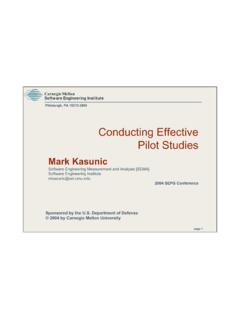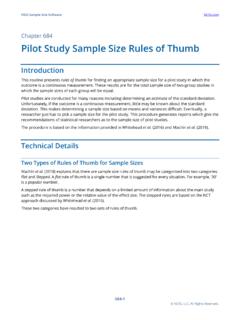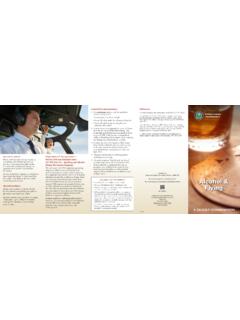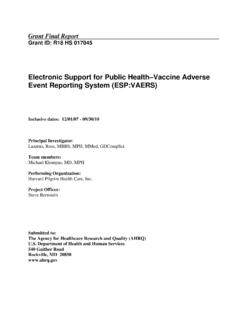Transcription of 2018 Pilot Testing for Feasibility in a Study of Student ...
1 International Review of Research in Open and Distributed Learning Volume 19, Number 1 February 2018 Pilot Testing for Feasibility in a Study of Student Retention and Attrition in Online Undergraduate Programs Joy Fraser, Dorothy (Willy) Fahlman, Jane Arscott, and Isabelle Guillot Athabasca University, Canada Pilot studies are "underdiscussed, underused, and underreported." (Prescott & Soeken, 1989, ) Abstract Prior to undertaking a descriptive Study on attrition and retention of students in two online undergraduate health administration and human service programs, a Pilot test was conducted to assess the procedures for participant recruitment, usability of the survey questionnaire, and data collection processes.
2 A retention model provided the conceptual framework for this investigation to identify and organize various factors that influenced students decisions to either discontinue or continue their educational programs. In an attempt to contribute to the body of research in this area and to enrich pedagogical practices, the authors describe the Pilot Testing processes and Feasibility issues explored, and the improvements made to the instrument and methodology before commencing the main research Study on attrition and retention. Keywords: Pilot Testing , Feasibility Study , attrition, retention, model, health administration, human service, online, undergraduate, students, distance education Introduction Retaining students is both a priority and an unrelenting challenge in higher education, whether in conventional face-to-face settings or in distance education (Tinto, 1975, 1982; Berge & Haung, 2004; Pilot Testing for Feasibility in a Study of Student Retention and Attrition in Online Undergraduate Programs Fraser, Fahlman, Arscott, and Guillot 261 Heyman, 2010; Rintala, Andersson, & Kairamo 2011).
3 Tinto s (1982) analyses of undergraduate degree completion rates from 1880-1980 prompted him to say rates of dropout from higher education have remained strikingly constant over the past 100 years (p. 694). He observed that students were dropping out at a rate of 45% with little variation over time. More than three decades after Tinto s Study , the problem of retention persists in higher education generally, and is an even greater concern in distance and distributed learning contexts. Indeed, attrition and retention became the focus of concern for an investigation in the Bachelor of Health Administration (HADM) and Human Service (HSRV) programs delivered online at a single open and online university. As a precursor to the main descriptive Study on attrition and retention, a Pilot Study was conducted to determine the Feasibility of using a survey questionnaire and the recruitment and data collection processes.
4 The online survey instrument was structured around a retention model that the researchers had not previously employed. It was believed that the model would provide an effective framework for organizing the factors contributing to students decisions to either discontinue or continue their online studies. Historically, Pilot and Feasibility studies were not usually reported, and nor were they topics of much discussion in the research literature. While to some extent this continues to be the case in educational research, Pilot and Feasibility studies have recently become the focus of extensive debate in the health-related literature. It would be beneficial if similar attention were given to Pilot and Feasibility studies in the broader research context, including the education community.
5 In an attempt to contribute to the body of research in this area, the authors describe the Pilot Testing process, the specific Feasibility issues explored, and modifications made to prepare for the main Study on attrition and retention in distance education. First, some background information is provided, including a definition of terms; followed by a discussion of the purpose, differences, and similarities of Pilot and Feasibility studies described in the literature. The definitions and purposes proposed in the health research are relevant to and help inform educational research, and are therefore included in the background discussion in this paper. Background on Pilot and Feasibility Studies Definition of Terms In general, a Pilot precedes and is closely related to a larger Study (Prescott & Soeken, 1989; Lancaster, Dodd, & Williamson, 2004; Eldridge et al.)
6 , 2016). A Pilot is often viewed synonymously with a Feasibility Study intended to guide the planning of a large scale investigation (Thabane et al., 2010, p. 1). In effect, pilots comprise a risk mitigation strategy to reduce the chance of failure in a larger project. The word Pilot has several different meanings in the research literature; however, as Eldridge et al. (2016) point out, definitions of Pilot studies usually focus on an experiment, project, or development undertaken in advance of a future wider experiment, project, or development. In other words, a Pilot Study facilitates decision-making, and therefore serves as a small-scale experiment or set of observations undertaken to decide how and whether to launch a full-scale project (Collins English Dictionary, 2014, para 1).
7 Pilot Testing for Feasibility in a Study of Student Retention and Attrition in Online Undergraduate Programs Fraser, Fahlman, Arscott, and Guillot 262 An informal term often used for Feasibility is doability; Eldridge et al. (2016) observed that outside of the health context, definitions of Feasibility and Feasibility studies focus on the likelihood of being able to do something easily or conveniently, and on the assessment of the practicality of a proposed plan or method (para. 16). Moore, Carter, Nietert, and Stewart (2011) noted that Pilot studies imply Feasibility to the extent that they are preparatory studies designed to test the performance characteristics and capabilities of Study designs, measures, procedures, recruitment criteria, and operational strategies that are under consideration for use in a subsequent, often larger, Study (p.)
8 332). There is no clear distinction between pilots , Pilot trials, and Feasibility studies in the way the terms are used (Thabane et al. 2010). van Teijlingen and Hundley (2002) argued that [t]he term ' Pilot studies' refers to mini versions of a full-scale Study (also called ' Feasibility ' studies), as well as the specific pre- Testing of a particular research instrument such as a questionnaire or interview schedule (p. 1). Bowen et al. (2009) similarly used the term Feasibility Study to encompass any sort of Study that can help investigators prepare for full-scale research leading to intervention (p. 453). Arain, Campbell, Cooper, and Lancaster (2010) do not agree that the terms Pilot and Feasibility can be used interchangeably; these authors contend that a Feasibility Study is undertaken to determine important components critical to the development of the main Study , whereas a Pilot Study is the conduct of the main Study in miniature.
9 This aligns with others who suggest that due to the specific goals of each, Pilot and Feasibility studies are mutually exclusive. For example, Bugge et al. (2013) noted that Feasibility studies are designed to ask questions about whether the Study can be done and they agreed that Pilot trials are a miniature version of the main trial, which aim to test aspects of Study design and processes for the implementation of a larger main trial in the future (p. 2). The numerous, and conflicting definitions and interpretations; differences in current usage, and diverse opinions in the health research community regarding the concepts of Pilot and Feasibility ; motivated Eldridge et al. (2016) to undertake extensive work to clarify the issue.
10 They concluded that rather than viewing Pilot and Feasibility studies as separate entities, Pilot studies are best defined as subsets of Feasibility studies; therefore, Feasibility is conceptualized as an overarching concept for studies assessing whether a future Study , project or development can be done (para. 23). This means that all studies aiming to assess whether a future [randomized control trial] RCT is doable [are defined] as Feasibility studies " (Eldridge et al., 2016, para. 30). Hence, a systematic review or meta-analysis of the research literature could be classified as a Feasibility Study , but not as a Pilot Study . Moreover, these authors determined that although all Pilot studies are Feasibility all Feasibility studies are Pilot studies (Eldridge et al.)
















